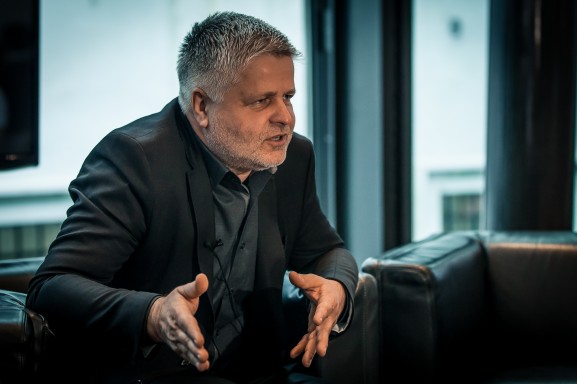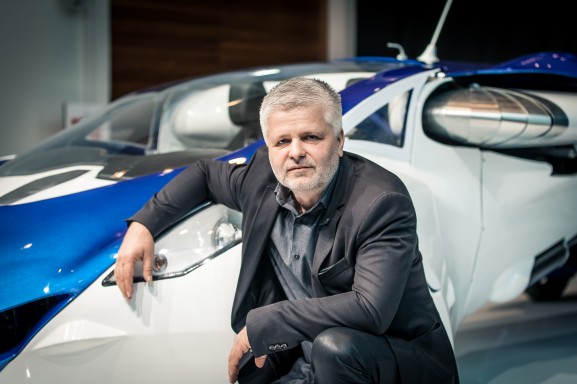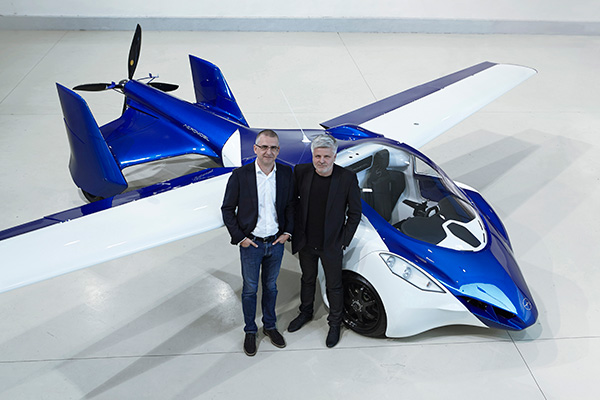From the Jetson’s Hovercar to the Delorean, movies always played with the dream of many childs and adults alike: A flying car. Štefan Klein has devoted the last 25 years into making this vision a reality.
With the help of Juraj Vaculik, a student friend from the time of the velvet revolution, now CEO of Aeromobil, he created the current prototype, Aeromobil 3.0. It was presented for the first time in October 2014 at Pioneers Festival in Vienna and helped the project gain international media coverage, including the front pages of Reuters, The Guardian and Wired, just to name a few.
We met in the press area of Pioneers Festival. He wore a grey suit and shirt, white three day beard and a conspicuous shine in his eyes.
Štefan gave us insight into the development of Aeromobil 3.0, his background, future plans and his everlasting motivation to create a new category of tansport vehicles.
DD: How do you feel about the tremendous media attention your project is receiving after almost 25 years of development?
SK: It’s an incredible feeling. I developed this idea for almost 25 years. Practically it was my childhood dream. I initially started this project because I wanted to do something that makes me feel passionate. And this feeling I have now. Passion and Freedom. These are the two feelings I gained with this project. For me, flying is all about connections and passion. And nowadays I’m missing the passion for flying and I would love to give it back to people. This connection of speed, dynamism, new perspective and freedom.
DD: What role did history, the separation between East and West through the iron curtain in particular, play for your project?
SK: You know, my childhood was during the times of socialism. My father and me developed a lot of flying objects. I flew in an air club, but we wanted to make something ourselves in our garage. And it was prohibited. We were under control of police. We captured our progress on 8mm material during that time, which was very dangerous for us. After the revolution, the police had all information about us. This is a tragical experience. But right after I finished art school, the velvet revolution took place and the new political situation gave me an absolutely new perspective. Two months after the revolution I visited France and I started a postgraduate study in St. Etienne, France and Aeromobil 1.0 was its topic.

DD: Which role did your father play in the development of your interest in flying?
SK: When I finished school as designer, I wanted to make something very practical as a designer, because designers need to solve problems. And a problem for me was the connection between earth and air. After that I started lots of concepts. I changed the concepts many times. Because the first concept was a non-transformational object. And this prototype is transformational. It switches from clean car to clean flying object.
DD: Do you remember the moment of inspiration that led you to draw your first flying object?
SK: Yeah, I remember that exactly. My main inspiration came from Jules Verne (French author of dreamy books about flying) and from the movie French movie Fantomas se Dechaine (the film featured a Citroen DS that could turn into a rocket). Another inspiration was a discussion with my father. He was a big dreamer who wanted to make something different. I think these three points were my biggest sources of inspiration.
DD: Aeromobil is no mainstream transportation vehicle, what was your ambition behind the project?
SK: You know, it is between aircraft and car. And my ambition was to create an object that requires a new, autonomous category of transportation vehicle. I didn’t want to make a car with wings, nor a plane with four wheels. I wanted to make something very autonomous which expresses my feelings. Concerning the shape, I had to respect aerodynamics, because it’s an aircraft. But at the same time, I wanted to create something similar to a sporting car. So in general I was going for a shape which is very dynamic and very attractive. These were the core ideas when I started to work on the first sketches.
DD: Do you think that your concept will also be applicable in cities one day?
SK: I don’t think that Aeromobil will be a solution for city centers. The problems of city centers must be solved by reduction, not expansion. But of course it can be a concept of transport for the connection between cities. Distances of more than 500 kilometers are a perfect usecase. For example when I fly on holidays to Croatia, I fly 2 hours from my hometown Nitra in Slovakia to Zagreb. Nowadays, this would take me way more time, simply taking the taxi to the airport could take me an hour. My aim is to create a vehicle that makes personal door to door travelling possible with a vehicle that you can have in your garage. Of course you could also fly by small plane, but these are very expensive. The reason for that is that you must pay for maintenance, for example you need to pay for a hangar , which is very expensive. The price of the plane itself wouldn’t be that high, it’s basically the price of a sporting car. My aim is to solve this issue by building a very practical solution that brings you from A to B very efficiently.
DD: What is the legal standpoint? Can you already use Aeromobile?
SK: Right now we build this prototype under legislation for micro weights, which means that the flying object needs to weigh less than 600 kilograms. At the moment, Aeromobil is open for a flight program, because it is prototype. We have the chance to fly absolutely legal as a plane and aim to have the same situation for the car. The car has very special markers for prototyping. After the testing phase, we would like to open certification, though of course this is a very problematic and time consuming process. Our ambition is to start with the preparation of a new category of transportation vehicles: Flying cars. If you have a motorbike, you must not accept legislation for the car, you have a special legislation for bikes, there’s one for trucks, and I hope there will be a special specification for flying car in the future.
DD: What kept you motivated over the last 25 years?
SK: I remember, I spent a lot a lot of time in my studio, because I started the project in a conventional garage. I have spent a lot of energy into a lot of models and prototypes. I must admit that there was a moment where I just wanted to finish the project, because my energy had limitations. But when I flew Aeromobil 2.0 for the first time, I was absolutely enjoying it, because I saw that the project had an absolutely realistic base. From that time on, I didn’t have any moment where I’d say: NO.
Then I met up with my friend from the academy of dramatic art, Juraj Vaculik. We were part of the movement around the velvet revolution in 1989. When I met Juraj 20 years later, we talked about bureaucracy, freedom and about my project and suddenly he said: I will support you. From this moment we started to think big. He invested a lot of money in the development of the engine and in the professionalization of the project in general. During the course of one year we created prototype 1.5 which was our proof of concept. I flew this model at an altitude of 200 meters and it gave us the evidence that this concept has a chance in the future.
We presented it for the first time at an aviation conference in Montreal organized by NASA and Boeing and for the first time in my life I met people from NASA. This was a huge satisfaction for me, meeting these these iconic people and preparing a new category of transportation vehicle, namely “Flying Car”. And these people were very surprised because for the first time we presented a flying car which really had the capability to fly. This was at the end on 25th of September, 2013. The reaction of media outlets around the world was tremendous. After we flew back from Montreal, Juraj said: we need to accelerate the development, which led to the current prototype 3.0, which was built by a small team during the course of 10 months.
DD: Do you remember the first time you watched the movie “Back to the Future”?
SK: I actually never watched it. I saw a lot of James Bond – Fantomas. It was my inspiration.
DD: What kept your motivation up for such a long time and what drives you in general?
SK: I have a very good family background. Because my wife is fashion designer and my son is pilot. I come out of a family of aviators. My brother is captain on an airbus, my nephew is captain on an airbus. It was a very strong motivation for me as at home we only discuss about aviation (laughs). And of course my friends and team stand 100% behind the project. I feel that now is the perfect time for a next acceleration phase.
DD: What are your next steps?
SK: This is a prototype. In aviation you must test a prototype and collect information. Because I know, that this prototype is not ideal, our future target is to integrate the gained information into the next prototype. And we prepared several concepts with hybridization, with different engines, with propellors, etc. Our aim is to make flying Aeromobil as simple as possible. Version 3.0 is equipped with auto-pilot functionality. It is a new quality for young pilots without experience. Because when I started flying, planes were equipped with very simple avionics, I had a map on my knee and each flight that was longer than 500 km was very very dangerous. We didn’t have any information about weather, navigation etc. If I compare that now with before 10 years, we have a completely new situation. Because young pilots without experience can fly very safely. On board they have all information about weather, navigation, etc.. Technology, passion and safety, that’s the things we focus on.
DD: Do you plan to stay in Slovakia or will you move to Silicon Valley?
SK: I want to state Central Europe as an example. Slovakia has no history in aviation, but it has 5 aircraft production companies. In czech republic we have very good access to the university in Brno (Czech Republic), in Salzburg (Austria) we have a perfect company for carbon production. We would love to build a strong network between Slovakia, Czech Republic and Austria. And we have this history here, I would love to use this. For example my grandfather started to fly with Austrian aircraft to Brandenburg. I have very old photos in my archive, where my grandfather is in a romantic position. I see the potential is here right now. I see it in my students at the academy of fine arts, a small country like Slovakia is able to have perfect designers for VW, Audi or BMW. One of my former students, Josef Kabaň, was responsible for the design of the Bugatti Veron, for example.
DD: Your grandfather started your family tradition in the field of aviation. Did you know your him?
SK: No, he died before my birth. I know him only from photos.
DD: If you could choose to meet a historic personality, would it be him?
SK: I must tell you a very intimate story. When I was in the cockpit of Aeromobil 3.0 for the first test flight, I was in contact with my grandfather and I said to him: Probably you’ll see me now and hopefully, you will help me.
DD: What do you want to achieve before you die?
SK: My dream is to work with my son the same way I worked with my father and my father did with my grandfather. I would love to keep this line in the family.
More information:
Official Product Video:
Official Website: http://www.aeromobil.com/

Contributed by Manuel




